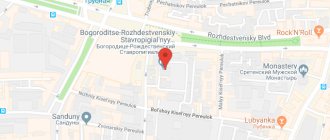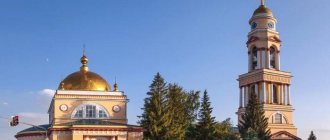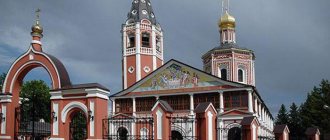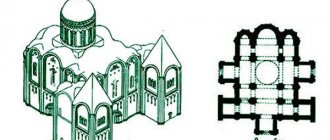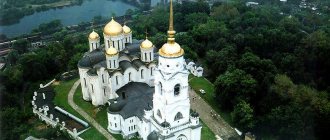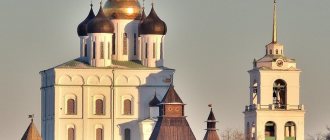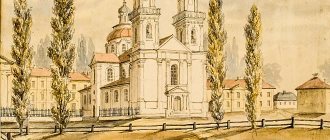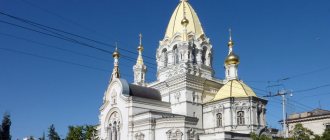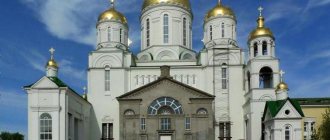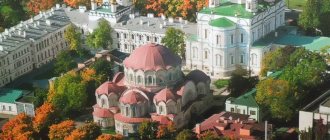I live in Vladimir, so I collected here photographs of the cathedral over several years. The photographs were taken in different seasons of the year and under different lighting conditions of the temple.
Click on the photos and they will open in larger format
- Pages of history
- Architectural features of the cathedral
- Carving of St. Demetrius Cathedral
- Interior of Dmitrievsky Cathedral
- Observation deck at the cathedral
History of construction
The cathedral was built by order of Prince Vsevolod III during the period of the highest power and prosperity of the Vladimir-Suzdal principality as a home church behind a blank white stone fence in the grand ducal courtyard.
He received the nickname Big Nest for his large family and large number of children: in total he had 12 children. By the beginning of the construction of the house church, a son, Dmitry, was born into the princely family. The prince himself was given the same name at baptism. In honor of the great Christian martyr Dmitry of Thessalonica, his heavenly patron, he erected a white stone church at the very end of the 12th century.
Dmitrovsky Cathedral in Vladimir, according to historians and archaeologists, was built by Russian architects in the period from 1194 to 1197 from white soft stone - limestone. The skillful ornamental carvings decorating the facades of this majestic building gave rise to the epithet “white stone poem”.
In 1237, the cathedral was attacked by Batu Khan and was looted and set on fire by the Tatar-Mongol conquerors.
In the period from the mid-16th to the 18th centuries, the temple had to survive three more devastating fires, but each time it was possible to restore it, although with a partial loss of ancient decorative elements.
During the reign of Ivan the Terrible, the church was completed with two boundaries: in the north, in honor of St. Nicholas the Wonderworker and the Beheading of John the Baptist in the south, and on the western side, an extensive porch was built.
At the beginning of the 19th century, the cathedral underwent another major renovation and reconstruction. A bell tower is being built over the ancient boundary, and a porch is being added to the west. A little later, the ancient wooden roof was completely replaced with an iron one. The iconostasis was updated and gilded.
And by the end of the century, heating was installed in the temple through special channels and pipes from the oven in the gatehouse. This made it possible to hold year-round services and had a beneficial effect on the preservation of the frescoes.
The Dmitrov Cathedral in Vladimir was transferred to the museum's jurisdiction almost immediately after the revolution, and ceased liturgical life for a long time.
DEMITRIUS THE GREAT MARTYR OF THESOLUNKA CATHEDRAL IN VLADIMIR
The commission list of the Novgorod I Chronicle, reporting on Vsevolod’s buildings in the list “And these are the princes of Russia,” establishes - without mentioning the years of construction - their sequence: 4 tops of the Assumption Cathedral were built, “then Vsevolod erected a stone church in his yard of St. Dmitry in his Name. And then Vsevolod built the monastery of the Nativity of the Holy Mother of God..." (1st Novgorod Chronicle... P. 468). Year of construction D. s. indicated in the Chronicler of the Vladimir Assumption Cathedral (known in the collections of the 17th-18th centuries, stored in the cathedral): “In the summer of 6699 [1191], Grand Duke Dimitri Vsevolod erected a stone church in his yard in the name of the Great Martyr Demetrius and gilded its top.” (Shilov. 1910. P. 58).
Cathedral in the name of the Great Martyr. Demetrius of Thessalonica Cathedral in the name of the Great Martyr. Demetrius of Thessalonica
However, D. s. in the present Time is usually dated differently. The Laurentian Chronicle, reporting about the fire that happened on June 23, 6701 (1193) in Vladimir, when “half of the city was burned, and the prince’s court ... was quickly spared from the fire,” does not mention D. with., which gives reason to assume that the cathedral not yet; Its bookmark is dedicated to the birth of October 25th. 6702 (1194) from the book. Vsevolod's son Vladimir, baptized Demetrius. The end of construction is considered to be the bringing and installation in the cathedral on January 10. 6705 (1197/98) Byzantine icon of the Great Martyr. Dimitri.
Dedication to the book. Vsevolod's council to his heavenly patron (“in his name”) makes the connection to the birth of his son unnecessary. Therefore, the date of 1191 seems more likely, and the use of the word “set” by the chronicler of the Vladimir Cathedral speaks not of the foundation, but of the completion of construction, i.e. D. with. could have been founded no later than 1187/88. The palace princely temple, which upon completion of construction became a reliquary of the common Christ. shrines - icons (“grave boards”) of the great martyr. Demetrius, was supposed to follow the prince’s temple-building plans. Vsevolod for renovation after the fire of the main temple of the principality - the Assumption of the Most Holy. The Cathedral of the Virgin Mary in Vladimir, where other Byzantines were kept. shrine - Vladimir Icon of the Mother of God.
The Laurentian Chronicle connects evidence of D. with. with a story about the shrines of the Great Martyr. Demetrius under 6705: “The same winter was brought quickly from Selunya the grave hundred [go] of Demetrius in the month of Genvar on the 10th day” (PSRL. T. 1. Stb. 414) - and under 6720 (1212), in Pokhvala Vsevolod (1st mention of the cathedral in sources): “He created many churches according to his authority, for he created a beautiful church in his courtyard of the holy martyr Dmitry, and wonderfully decorated it with icons and writings, and brought the tomb plaque from Selun of the holy martyr Dmitry, muro constantly striving for the health of the weak, place it in that church, and put the same shirt of the same martyr” (Ibid. Stb. 436-437; T. 7. P. 118).
The idea was to create a new reliquary of the Great Martyr in the Principality of Vladimir. Demetrius, patron saint of the Byzantines. courtyard, turning Vladimir into Second Thessalonica, could mature with the prince. Vsevolod long before his reign in Vladimir - during his stay during the period of exile (1162 - approximately until 1169) in K-field (PSRL. T. 2. P. 521) at the court of the emperor. Manuel I Komnenos. In March 1149, the emperor transported from the basilica in Thessalonica to the Polish monastery of Pantocrator a miraculous cover with the image of the great martyr. Demetrius, and in 1158-1160. sent several Thessalonica shrines as a gift to St. Kng. Euphrosyne of Polotsk. Prince's mother Vsevolod could also bring with her a piece of Thessaloniki shrine as a dowry. Like imp. The shrines of the great martyr could receive a blessing before returning to his homeland. Demetrius from Thessalonica Basilica and Prince. Vsevolod. The addition (“place the shirt of the same martyr”) to the chronicle text about the myrrh-streaming “tomb board” suggests that the shrines came to Vladimir at different times; tribute to special worship of the Great Martyr. He gave the book to Dimitri. Yuri Dolgoruky, who named the city (Dmitrov) in his honor and named his son Vsevolod, was baptized Dimitri.
Vmch. Demetrius of Solunsky. Icon. Ancient painting with a record of 1701. Icon painter Kirill Ulanov (Assumption Cathedral of the Moscow Kremlin)
Vmch. Demetrius of Solunsky. Icon. Ancient painting with a record of 1701. Icon painter Kirill Ulanov (Assumption Cathedral of the Moscow Kremlin)
In D. s. The “grave board” became a temple image. The icon was placed either at the southeast. pillar, or in the south. parts of the altar barrier. After 1380 (probably in 1390-1400) by order of Prince. Dimitri Donskoy it was transferred to the Assumption Cathedral of the Moscow Kremlin (now there, under the record of 1701 by Kirill Ulanov).
Dr., located in D. s. the shrine was a “shirt” - a piece of clothing or cloth covering from the body of a martyr, possibly with his sewn image. If this particle was small enough, then the frame for it could be a temple-shaped reliquary, now located in the Armory Chamber of the Moscow Kremlin. Perhaps there were other images of the Great Martyr in the temple. Dimitri.
In 1218 Polotsk bishop. Vladimir said “bring it.” book Konstantin Vsevolodovich “here is a portion of the Passion of the Lord... and the relics of St. Login the martyr, the centurion, both holy to his hands, and the relics of St. Mary Magdalene” (PSRL. T. 1. Stb. 441). In a solemn religious procession, the relics were transferred to the D. village. Nothing is known about their further fate.
In 1194-1196. D. s. (together with the prince's palace and the Assumption Cathedral with the bishop's courtyard) was surrounded by the wall of Detinets, which occupied a significant territory in the southwest. parts of the Pecherny (Middle) city. With the loss of political independence by Vladimir, and the loss of princely status by the cathedral, the place of the princely court was taken by the voivodeship court, then by the provincial chancellery. In 1238 D. s. survived the Tatars. ruin, but still in the beginning. XVI century was considered a grand duke. The grant of 1515 (GVSMZ), given by Vasily III Ioannovich to the cathedral clergy, has been preserved: “Behold, the Great Prince Vasily Ivanovich of all Russia has granted his priests, who serve in my cathedral church near St. Demetrius in Volodymyr, inside the city, in my yard ..." During the fire of 1536, the entire roof of the village burned down. The repairs were carried out after the trip (1552) to Kazan of Ivan the Terrible, who visited Vladimir on the way. According to the scribe book of 1625/26, the temple was simply “in the city” (RGADA. F. 1209. Op. 1. No. 71. L. 1).
In the letter ser. XVI century Tsar John IV Vasilyevich on the procedure for remembering the “Vladimir” princes and rulers to priests and deacons D. s. it was prescribed to serve together with all the city clergy: “... to sing vespers, and all-night vigil, and to serve mass at the cathedral” November 23, in memory of St. blgv. book Alexander Nevsky, “18 memorial services for princes and lords of power” in the Assumption Cathedral and especially a “requiem service” in the Vladimir St. George Monastery “for Prince Fyodor Yaroslavich” (Shilov. 1910. pp. 65, 68).
In the 18th century altars were placed in the extensions: the southern one was consecrated in honor of the Nativity of St. John the Baptist, northern - in the name of St. Nicholas; 3rd, last the abolished throne - in honor of the Entry of the Lord into Jerusalem. The time of their appearance is correlated with the period of the reign of Ivan the Terrible; in 1647, under Patriarch Joseph (1642-1652), the altars of the temple and its aisles were listed as dilapidated. The southern aisle was heated by a stove, and a tent-roofed bell tower was built above the northern tower.
In 1719, the building was again damaged by a city fire and stood for a long time without repair. In 1756, the temple was striking in the dilapidation of the wall paintings, in addition, “on the church the dome and the cross (which were gilded) had darkened and rusted over the years... the entire roof was rotten” (GA Vladimir Region F. 556. Inventory 1. D. 122. L. 1). A fire also occurred in 1760. In 1778, the clergy of the cathedral asked to fix the iconostasis and the brick floor. From the inventory of 1781 it follows that the head of D. s. “upholstered in copper and gilded, a gilded iron cross”, the church is covered with planks, there is no real iconostasis (Ibid. D. 1399. L. 32). The inventory of 1784 mentions a new white iconostasis, without icons, low and ungilded, as well as 6 bells (Ibid. L. 32 vol.). In 1788, icons were painted, the floor of the altar was raised, and the temple was consecrated (Ibid.). In con. XVIII century D. s. was again in need of repair: the roof and the roof had become dilapidated and were leaking, which caused dampness and mold (GVSMZ OR. V-5636/462. L. 233). For centuries, the cathedral remained a church without a parish. According to the Decree of the spiritual government of September 15. 1794 D. p. was placed under the supervision of the archpriest of the Assumption Cathedral. During services, the same bell ringing as the Assumption Cathedral was used, and land holdings were also considered common (Ibid. L. 220).
Cathedral in the name of the Great Martyr. Demetrius of Thessalonica. Rice. F. D. Dmitriev based on the original by F. G. Solntsev. 1831 (GMMK)
Cathedral in the name of the Great Martyr. Demetrius of Thessalonica. Rice. F. D. Dmitriev based on the original by F. G. Solntsev. 1831 (GMMK)
External appearance of D. s. of this period is depicted in the panoramic watercolors of the “Atlas of the Vladimir Province”, for which he performed drawings from life (1799). architect I. P. Chistyakov. The roof of the cathedral is 4-slope, hiding the lower part of the drum, the dome is helmet-shaped, a cross on the dome is with a “crescent” at the bottom and a dove at the top. The cathedral is shown from the west. sides. Middle window The façade, initially narrow, looks like a wide rectangle. Lower tier The façade is covered by a gallery covered with a pitched roof with keel-shaped ends and a portal. The left (north) tower, complicated by an arcature-columnar belt, protrudes beyond the west line. facade. Above it was built a bell tier, rectangular in plan, with a low faceted tent and dome. The right (southern) tower, unlike the left (northern) one, does not protrude beyond the line of the western facade, is covered with a pitched roof, and there is no bell tower above it. It is unclear from the drawings whether the south had. tower carved reliefs.
In 1805, 8 thousand rubles were received for the repair of the cathedral, on which the iconostasis was gilded, painted and varnished, and new carved royal doors were installed. In 1806-1807 2 stone porches were rebuilt (west porch with 8-column pediment); north The bell tower was rebuilt in the form of a spire, facing south. a bell tower was also built symmetrically on its side. The roof of the church, the aisles and both bell towers was covered with iron, the dome was covered with old material, 4 domes were built on 2 aisles and 2 bell towers, staircases were erected “with a turn” to both bell towers, a valance was made around the entire roof, crosses were placed on the domes , the carvings on the outside were repaired and painted. Despite this, D. s. continued to deteriorate and collapse.
Imp. Nicholas I, during his visit to Vladimir in 1834, expressed a desire to bring D. with. into a “primitive form”, which resulted in the destruction of galleries and towers. A preliminary research carried out by a special commission on the antiquity of the galleries was not crowned with success, and the stylistic difference between the galleries and the cathedral suggested their appearance in the 16th century, during the renovation carried out by order of Tsar Ivan the Terrible after the fire of 1536. In 1838-1839. the galleries and towers were dismantled, and the intact reliefs from them were used to repair losses in the facades of the cathedral. Mn. the missing reliefs were carved according to old models. The stone work was carried out by the contractor S. Medvedkin, a peasant from the village. Poretsky near Suzdal.
Shortly before the renovation, in 1831, F. G. Solntsev captured the cathedral with galleries and towers in a series of watercolors (GMMK). In the drawings of the south. the tower protrudes beyond the west line. facade, because it has not 1, but 2 spindles, which contradicts the drawing of 1799.
In 1840-1847, after the completion of external work, renovations took place inside the building. The walls were “forged” (late paintings and whitewash were knocked down), ancient frescoes were discovered under the choir. The temple was re-painted, a new iconostasis was installed, an oak spiral staircase to the choir (still exists), the floor in the temple was lowered by an arshin; soil was poured to the same height. He supervised the work first from the lips. architect E. Ya. Petrov (1839), then several. months captain Stanitsky, and from 1840 lips. architect Y. M. Nikiforov. The cathedral was consecrated on August 24. 1847
In 1848-1850 at the expense of the head of the cathedral, merchant of the 1st guild A. N. Nikitin, the dome was covered with new copper with a gilded mesh; old copper sheets with fire gilding remained with the merchant. In 1857 the roof was damaged by a storm.
Divine services in D. s. were performed only in the summer (the temple was closed after October 26, the day of remembrance of the Great Martyr Demetrius). In winter, they served only in the warm aisle (dismantled along with the galleries). In 1883, calorific heating appeared in the temple, which made it possible to perform year-round worship. Near south façade, a small belfry was built, in which a stove was placed. These works were carried out on the initiative of the rector of the cathedral, Rev. V.V. Kosatkina according to the project of academician. architecture by A. M. Pavlinov at the expense of the head of the cathedral V. N. Muravkin.
Until 1883 (or 1896), the reliefs were covered “to protect the stone from weathering” with white paint or whitewash, the walls with colored or dark paint, later the reliefs were painted with dark paint, and the walls with white.
Nothing is known about the ancient necropolis of the cathedral. In 1783, out of respect for his merits and according to his will, Count was buried in the cathedral. R.I. Vorontsov - 1st governor of Vladimir province. In 1804, his sons erected a tombstone. Allegorical figures - a mourner bending over an urn with a cypress branch in her hand and a boy with a pelican (one of the symbols of Freemasonry, to which Vorontsov belonged) - were sculpted from white marble in London. The background for the sculptural group is a pyramid of gray marble - an allegory of eternity. The pyramid, made in the Moscow workshops of I. P. Vitali and S. P. Campioni, was installed during the renovation of the cathedral in 1841 at the expense of Vorontsov’s grandson, Novorossiysk governor M. S. Vorontsov. In terms of style and quality of execution, the tombstone belongs to the best examples of memorial sculpture of the early. XIX century The tombstone stood at the south. walls - where the burial is located under the floor. In 1896 or 1906, when the frescoes on the vault under the choir were renewed, the tombstone was moved to the west. wall, restored in 2003.
In 1919, with the separation of the Church from the state, D. s. came under the jurisdiction of the lips. Collegium for the Protection of Ancient Monuments - at first temporarily, until the formation of a new community of believers. Since the community was not formed, the cathedral remained under the jurisdiction of the state and was used by the Vladimir Museum as a storage facility. In 1945 D. s. came under the jurisdiction of the region. department of architecture. Upon completion of the restoration work, D. s. was again transferred to the museum; in 1955, an exhibition dedicated to Vladimir-Suzdal white stone architecture opened in the cathedral, which was active until the beginning. 70s In 2005, at the end of a large cycle of restoration work, in D. s. A new exhibition of the GVSMZ has been opened: “Dmitrievsky Cathedral of the 12th century - a unique monument of ancient Russian architecture.” The main “exhibit” of the exhibition was the cathedral. It contains copies of 2 icons of the Great Martyr. Demetrius: “tomb boards” and icons painted under Prince. Vsevolod for the city of Dmitrov. The only three-dimensional display case contains fragments of an ancient cross and a dove from it, a charter of 1515, several. archaeological finds of Domong. time. On the day of remembrance of the Great Martyr. Demetrius a prayer service is being held in the cathedral. In 1992 D. s. included in the UNESCO World Cultural Heritage List.
T. P. Timofeeva
Architecture
Architecturally, the cathedral is distinguished by its compositional clarity; it is of the Byzantine type, four-pillared, with three semicircular apses on the eastern side.
The head of the cathedral is one, helmet-shaped, on a high drum, crowned with a ball with a 4-pointed gilded cross with a dove on top. This dome shape is one of the hallmarks of ancient Russian architecture until the 16th century.
The following elements were borrowed from Romanesque architecture in the temple:
- perspective of portals and windows;
- masonry technique;
- decorative false arches on the facade.
The cathedral is small in size. Initially, it was a house church for the prince and his family, surrounded by long galleries and staircases, connecting to the prince's chambers.
White stone carving
Dmitrovsky Cathedral is famous for its unique stone carvings, created by the best Russian and Serbian craftsmen of that time, gathered in Vladimir.
Today's people do not fully understand the meaning of many patterned images and symbols. More than six hundred carved stone images form intricate pictures of the Christian world mixed with pagan myths and literary heroes.
It is assumed that the original idea for the sculptural design of the cathedral was the theme of power: Alexander the Great, King David, figures of the Grand Dukes and their sons.
Real and fantastic plants and animals are carved under each of the figures:
- lions;
- pigeons;
- griffins.
The western walls are decorated with three reliefs with stylized illustrations of the labors of Hercules. There are images of the biblical hero Samson.
The main sculptural compositions are dedicated to the prophet, musician and psalmist King David - the prototype of Christ. The New Testament theme is also supported by images of a number of ancient Christian saints in patterned medallions, but they were carved much later, in the 19th century. They look more primitive and rough.
The reliefs on the western wall with the figures of seated saints are authentic, taken from the destroyed towers during reconstruction. They are distinguished by their special graphics and decorativeness.
Among the most famous and recognizable saints are:
- St. George;
- Demetrius of Thessalonica;
- the first holy Russian princes Boris and Gleb.
The northern façade has preserved images of Prince Vsevolod himself, the creator of the cathedral, with his sons and the younger Dmitry on his knees.
It is necessary to especially note the compositional diversity of stone reliefs: from battle scenes with warlike horsemen, formidable predators and bloody struggles to heavenly visions and illustrations of psalm texts praising the Lord. The stones are very different in the manner of execution.
There are two main types of carvings in the cathedral decoration:
- high relief with great plasticity of the image;
- flat relief with an abundance of details and ornaments.
Most of the decorative stone bas-reliefs have reached us in their original beauty; some of the carvings were replaced during the restoration of the Dmitrov Cathedral by craftsmen and staff of the museum in Vladimir.
Architectural features of the cathedral
Demetrius Cathedral is a classic example of the Vladimir-Suzdal school of architecture . Its features are very clearly manifested in the architecture of the temple. The building material of the temple was limestone. This white stone is durable, frost-resistant and at the same time easy to process.
The craftsmen used the semi-ruble masonry technique, known back in Ancient Rome.
Half rubble masonry
The architects hewed blocks of stone measuring 45-45-65 cm, polished them smoothly and fit them tightly together. Each wall consisted of two rows of masonry. The space between them was filled with crumbs, crushed ceramics, charcoal and filled with lime mortar.
The foundation of the temple is made of cobblestones and is lowered to a depth of one and a half meters. The bases of the columns are carved in the form of stylized animal paws with claws.
Dmitrievsky Cathedral is a cross-domed temple in the shape of a cube. The three facades of the cathedral are divided into three vertical parts - vyasla , each of which ends with semicircular vaults - zakomari .
The roof rests on the zakomari, which follows their shape and creates a wavy top line. On the eastern facade of the temple there are three semicircular projections, these are apses. If you remember that the altar in the temple is always in the east, then using the apses you can accurately navigate to the cardinal points.
The cathedral has narrow slit-like windows, which were also used as loopholes.
All the vaults and the head of the temple are made of porous tuff, since this material is much lighter than limestone. On the roof there is a cylindrical drum , which is topped with a helmet-shaped dome .
The dome ends with an openwork cross, on top of which a figurine of a dove is installed as a weather vane. There are different interpretations of the symbolism of the cross and crescent above the dome of the cathedral. Some people think that this is a victory of Christianity over Islam. However, we do not forget that the cathedral was built in the pre-Mongol period. Rather, the crescent is a symbol of the sacrificial cup into which the blood of Jesus Christ crucified on the cross flowed.
If you admire the Dmitrievsky Cathedral on your own, pay attention to the dark pink pavement along the perimeter of the temple. The fact is that initially the cathedral was surrounded by single-tier galleries. At the western corners they turned into staircase towers, which appeared (or were rebuilt) a little later than the temple itself. These towers connected the cathedral with the princely palace.
In 1839, by order of Nicholas I, the galleries were demolished, mistaking them for later buildings. However, it later turned out that they were built at the same time as the temple. Therefore, already in the 19th century, a pavement like this was made around the temple.
Facade decor
In the white stone carved decoration of the cathedral walls, a strict rhythm and clarity of tiers are clearly visible:
- The first lower belt of the facades is completely devoid of decoration, as it was originally hidden by auxiliary buildings: stairs and galleries to the princely mansions. These buildings were dismantled in the middle of the 19th century, and fragments of carvings were used to restore the lost reliefs of the building.
- The second tier is represented by rich carved ornaments of an arcature-columnar belt.
- In the upper zone there are tall and narrow lancet windows. He is all directed upward, personifying heavenly and spiritual aspiration. The third tier with a cylindrical drum is completely decorated with the finest openwork carvings.
Vertical pilasters segment the façade and subordinate the carved decor to the architectural structural integrity.
A distinctive decorative feature can be noted in the line and ornamentation of the ordered carving of the cathedral with its architecture. The stylistic rethinking of images by Vladimir carvers created the uniqueness and originality of the Russian sculptural decoration of the building’s facades.
Frescoes
The interior decoration of the church has practically not been preserved. The main attraction today is the precious frescoes of the 12th century, discovered in 1918. These fragmentary remains of a unique painting on the theme of the Last Judgment are located in the western part of the cathedral.
In the middle vault is an image of the main twelve apostles seated on thrones, with the angelic army of Christ behind. The faces of the apostles are recognizable, marked by portrait resemblance, and distinguished by the rigor and individuality of their writing.
The corner southwestern vault is occupied by a painting of the outcome of the Last Judgment - the introduction of the righteous into the heavenly abode by the first Supreme Apostle Peter, with formidable angels trumpeting. Particularly charming is the image of the Mother of God on the throne and the Old Testament righteous: Abraham, Isaac and Jacob in the whimsical Garden of Eden.
Artists achieve the sophistication of interior painting with the help of delicate colors and mother-of-pearl tones.
A serious analysis of the characteristic features of the painting style reveals the work of at least two masters:
- The image of the apostles and angels of the southern vault belongs to the Greek noble and sublime letter. The slenderness of the figures, the freedom of movement, the elegance of the clothes are filled with strict, sophisticated beauty and vitality.
- The Russian master painted the northern slope. The faces he painted are thoughtful and sincere, distinguished by their humanity, simplicity and sincerity.
The artistic style is characterized by ornamentation and graphics, which brings it closer to the external patterned carvings of the cathedral. A skillful combination of impressions of wildlife and mythological intricacy creates a poetic depiction of heavenly scenes and a sublime spiritual mood.
Interior decoration
The Dmitrovsky Cathedral in Vladimir was unable to preserve its interior decoration in all its pristine beauty due to the dishonesty of the restorers.
But the emptiness inside the temple only emphasizes the severity and solemnity of its interiors, emphasizing the space and height of the vaults, as well as the clear, calm rhythm of the arches.
Also included in the interior decoration is the most magnificent painting of the cathedral, which has survived to this day only a small part of the oldest frescoes. It is difficult to imagine the enormity of the impression that the completely painted original interior made on visitors to the temple.
Reviews
Demetrius Cathedral, century after century, confirms its uniqueness and significance for Russian culture. Thousands of tourists come to see it every year, and for everyone the white-stone temple becomes a revelation. Visitors say that the carvings on the walls are incredibly beautiful and are found almost nowhere else. You can look at it endlessly, there is so much of it on each of the facades.
Some complained that the exhibition inside the temple is very modest, but is compensated by the architecture and beauty of the building. Not everyone was able to get inside the cathedral, but there is an observation deck nearby, which offers views of the river and the surrounding landscape. Most tourists recommend visiting St. Demetrius Cathedral to personally feel the breath of time and the connection between generations.
Relics
The temple building was originally conceived as a precious casket - a reliquary for holy Christian relics.
Upon completion of construction in 1197, a large Byzantine icon on a coffin board with a full-length image and an ark with a piece of a shirt soaked in the blood of the holy martyr were brought to Vladimir from Greece from the Basilica of St. Demetrius of Thessalonica.
But in the 14th century, by order of Moscow Prince Dmitry, the icon was transported to Moscow to the Assumption Cathedral of the Kremlin, where it remains to this day, and later returned to Vladimir in the form of a copy.
You can also note the ancient four-meter cross stored in the cathedral, removed from the dome during restoration in 2002.
Where to stay
Vladimir is a hospitable city with a developed tourist infrastructure designed for millions of visitors. The top ten best hotels according to the ratings of some online resources include the park hotel Pearl of the Golden Ring, hotels at the Golden Gate, Erlangen House, Russian Village, Amaks Golden Ring, Prince Vladimir, Klyazma, Zarya, Dobroye, Motel Ochag. The price range is from 1880 to 5600 rubles per day per room. More economical accommodation in hostels Everest, Pilgrim, Samovar, Vozdukh, Wow - from 500 to 1990 rubles per day.
History of the restoration of the cathedral
All auxiliary structures were dismantled by order of Tsar Nicholas I, who visited the city in 1837. These works caused irreparable damage and almost caused the destruction of the cathedral, as they greatly weakened its structure. Irreversible damage was caused to the ancient appearance of the entire temple: the floor was lowered, the iconostasis and stairs to the choir were updated, and the walls were painted again.
Internal renovation work led to the almost complete loss of the oldest frescoes. Small fragments of them were miraculously discovered in 1918 by the commission for the preservation of painting monuments, headed by Igor Grabar.
Modern restorers have had to make a lot of effort to correct the gross mistakes of their predecessors. At the last stages of restoration work in the period 1999-2004, the domed cross was replaced, drainpipes were installed and a protective coating was made on the stone reliefs of the facades.
Inside the temple, scientists have created a favorable microclimate to maintain optimal humidity and temperature necessary for the preservation of museum exhibits and unique fresco paintings.
Repairs and restorations
Initially, after construction, the cathedral looked completely different. The central temple was surrounded on three sides by stone galleries, richly decorated with carvings. The first renovation work in the temple was carried out in the 15th century; the temple retained its grand ducal significance, but later the privileges were lost. In the 16th and 17th centuries, cosmetic work was carried out. No efforts were made to preserve the uniqueness of the temple; with each “improvement” it lost part of its individuality - decorative details and parts of the structure were lost, and frescoes inside the premises were lost.
The greatest damage, according to modern historians, was caused to the cathedral in the 19th century. Emperor Nicholas I arrived on a visit to Vladimir in 1834. Having examined the temple, he noticed its extreme disrepair. By his order, the church was restored to its “primitive appearance.” They got down to business with zeal, and as a result the ancient gallery was dismantled. They also barbarically got rid of the northern and southern towers with internal staircases leading to the choir.
After all the work, the Vladimir Cathedral irretrievably lost part of its identity, and the building’s structure was also damaged. In 1840-47, another “renewal” took place; now the ancient frescoes inside the temple were destroyed, and a new painting appeared in their place. The floor was also lowered, a new iconostasis was installed, and a spiral staircase was installed to access the choirs inside the room.
What does the cathedral look like today?
The Dmitrovsky Cathedral in Vladimir today is a museum reserve, and since 1992 it has been a protected UNESCO cultural heritage site.
Since Soviet times, church services were not held in the temple until 2011, when the first solemn liturgy in 200 years was celebrated on the patronal feast day.
One of the few ancient buildings that have survived to this day, thanks to the professionalism of modern restorers and learned historians, who have preserved and restored this precious example of ancient Russian architecture in a unique form.
How to get to the temple
Every day, electric trains run from Kursky Station in Moscow to Vladimir. Travel time is approximately 3 hours. You can get there on a branded train or on the Sapsan high-speed train, but it will be somewhat more expensive. Regular buses run from the Central Bus Station, near the Shchelokovo metro station. The journey will take the same amount of time as by train.
You can get to Vladimir's Cathedral Square, where the Dmitrievsky Cathedral is located, by buses and trolleybuses.
Demetrius Cathedral opening hours
| Days of the week | Working hours |
| Monday Wednesday Thursday | from 10:00 to 16:00 |
| Friday Sunday | from 10:00 to 17:00 |
| Saturday | from 10:00 to 18:00 |
| Tuesday and every last Wednesday of the month | Day off |
The ticket office closes 30 minutes before the museum closes.
What can you see inside the cathedral?
Inside, unique fresco paintings by outstanding ancient masters of the 12th century are available for viewing. As well as skillful decoration of the capitals of the internal pillars with white stone carvings.
Icon of the Holy Martyr Dmitry in the Dmitrovsky Cathedral
Of interest is also a copy of the oldest Byzantine icon of the temple's patron saint. It is worth paying attention to the ancient entrance gate with decorative elements.
The following historical objects are of interest as museum exhibits:
- An ancient banner as an example of ancient gold embroidery art.
- An elegant candlestick carved from wood from the early 17th century.
- Silver church utensils from 1714, donated by representatives of the royal dynasty.
- The oldest gospel of the 17th century.
- A written charter dated 1515 on parchment, granted by Grand Duke Vasily IV Ioannovich himself.
- Tombstone of 1804 of the first local governor, Count Vorontsov.
Peace and solemn calm permeate the entire interior of the cathedral, filling the space with cleanliness, light and air.
The Vladimir-Suzdal Museum Reserve is included in most tourist routes of ancient Russian architecture and is one of the most visited federal museums, ranking 6th in the ranking.
According to statistics, to date more than a million tourists have visited the Dmitrov Cathedral, a tenth of which were foreign guests of the city of Vladimir.
Article design: Vladimir the Great
